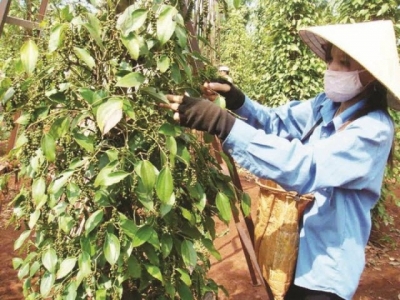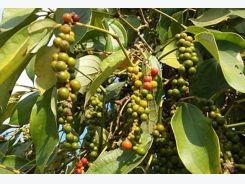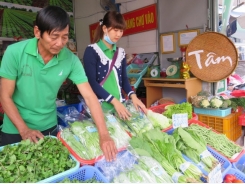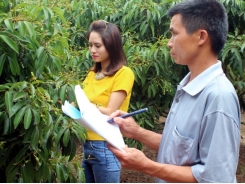The struggling price of pepper

The pepper is considered as "black gold" because of its high economic efficiency, but throughout the past, pepper prices continue to "slope”. This situation puts the pepper industry facing many difficulties as well as the need to recalculate the "problem" of development to be more sustainable in the future.
The price of pepper is only half of the same period last year. Picture: ST
Lowest price in 5 years
According to the Ministry of Agriculture and Rural Development, export volume in March was estimated at 24 thousand tons with the value of 88 million USD, bringing the volume of pepper in the first three months estimated at 54 thousand tons and 203 million USD, up 5.5% in volume but down 37.3% in value over the same period in 2017. Notably, the average export price in the first 2 months was only 3,822 USD / ton, down 44.7% over the same period in 2017. Vietnam's largest pepper market in the first two months was the United States, India, Pakistan and the United Arab Emirates with 43.5% market share.
Similar to export, pepper prices in the domestic market also recorded a significant decline. In the first quarter of the year, pepper prices tended to decrease with the decrease of 17,000-19,000 VND / kg compared with the end of 2017. At present, the pepper price in Daklak - Dak Nong, Gia Lai is 53,000 VND/kg. Pepper price in Ba Ria Vung Tau and Dong Nai is 54,000 VND/kg. Comparing with the same period last year, the above price is only half and a quarter of the price in mid-2016. On a wider scale, these are the lowest prices in the last five years. As for the reason, the Ministry of Agriculture and Rural Development point out: Pepper prices are down due to abundant supply and so demand is weak. Besides, there is the supply pressures from neighboring Cambodia, because this country is developing the pepper cultivation areas.
Further analysis on the "picture" of the pepper industry in recent years, Mr Le Van Duc, deputy director of the Department of Crop Production (MARD), said that due to the impact of drought and disease, the area of pepper in the world declined sharply.
According to the Food and Agriculture Organization of the United Nations (FAO), in the period 2006-2013, the world pepper area decreased about 158 thousand hectares. Of which, India lost 131.3 thousand hectares; Indonesia decreased 24.6 thousand hectares and Brazil decreased 7.4 thousand hectares ... The decline of this area led to shortage of supply, pushed up prices of pepper exports. By the year 2015, Vietnam's pepper price was about 200,000 VND/kg. This high price factor has led some producers to expand their pepper acreage, including intercropping in coffee and some other crops.
By 2017, the area of pepper in the country had reached 152 thousand hectares, yield reached 25.7 quintals/ha, production reached 243 thousand tons, accounting for 58% of the world’s pepper market share. The sharp increase of the pepper growing area without proper planning, even destroying the area of other crops to grow pepper, is seen as the key reason that the industry gradually tasted "bitter fruit”.
Needing more drastic
Responding to the question from the Customs Newspaper reporter on the problem of pepper development "hot", and constantly losing value as in the past, the Ministry of Agriculture and Rural Development has been giving solutions to overcome the problem, according to Mr. Le Van Germany: As early as January 2016, MARD issued Directive No. 132/CT-BNN-TT on developing sustainable pepper production. In particular, MARD requires the localities to review the entire area of pepper, evaluates planning implementation and pepper development of localities, clarifies the achievements and the existence of the planning rules and management, proposing solutions to manage effectively and timely to develop sustainable pepper. In 2017, the Ministry of Agriculture and Rural Development (MARD) has issued Official Letter No. 5429 / BNN-TT requiring the provincial People's Committees to focus on guiding, propagating, training, inspecting and developing measures for pepper development outside the region such as purely cultivated areas, severely damaged; At the same time, providing timely information on production, consumption and price forecasts for farmers to regulate production plans, not over developing pepper cultivation in the area.
Besides the given solutions, Mr Duc emphasized: "In order to manage the size of the pepper area step by step, MARD requires the local authorities to review the entire area of pepper, propagate, mobilizing farmers not to increase new planting areas; stop reforestation for old and seriously infected areas; Identify suitable crops to guide farmers to switch to other crops more effectively; Replacing part of the pepper cultivation area by intercropping pepper with perennial coffee and fruit trees in the area, reducing the intercropping pepper in the coffee garden. According to Mr. Duc, MARD also directed the locality to support the development of linkage production model based on the chain, the code of planting areas, certified production, the formation of production links between farmers and cooperative groups with processing enterprises, exporting pepper for sustainable development.
Recognizing objectively the problems of how to remove, even "rescue" the pepper industry from the "whirlwind" price reduction, towards sustainable development, many experts point out: The area of pepper growing increased massively and the error first belongs to the farmers because of their immediate interests and not caring for the long-term fluctuations of market supply and demand. However, the state management agencies have built the planning, conducting propaganda, mobilizing people, but can not stand outside. The overall solution as well as the details are outlined. It should be done soon and more drastically to really bring efficiency and real change, especially in the market of supply and demand assessment. Promotion should be done regularly to localities and people, as well as supporting the construction of linked models of pepper chain production ...
Related news
Tools

Phối trộn thức ăn chăn nuôi

Pha dung dịch thủy canh

Định mức cho tôm ăn

Phối trộn phân bón NPK

Xác định tỷ lệ tôm sống

Chuyển đổi đơn vị phân bón

Xác định công suất sục khí

Chuyển đổi đơn vị tôm

Tính diện tích nhà kính

Tính thể tích ao




 Co-operatives, clean farming methods help farmers raise the…
Co-operatives, clean farming methods help farmers raise the…  Labeling assistance to expand lychee consumption market in…
Labeling assistance to expand lychee consumption market in…